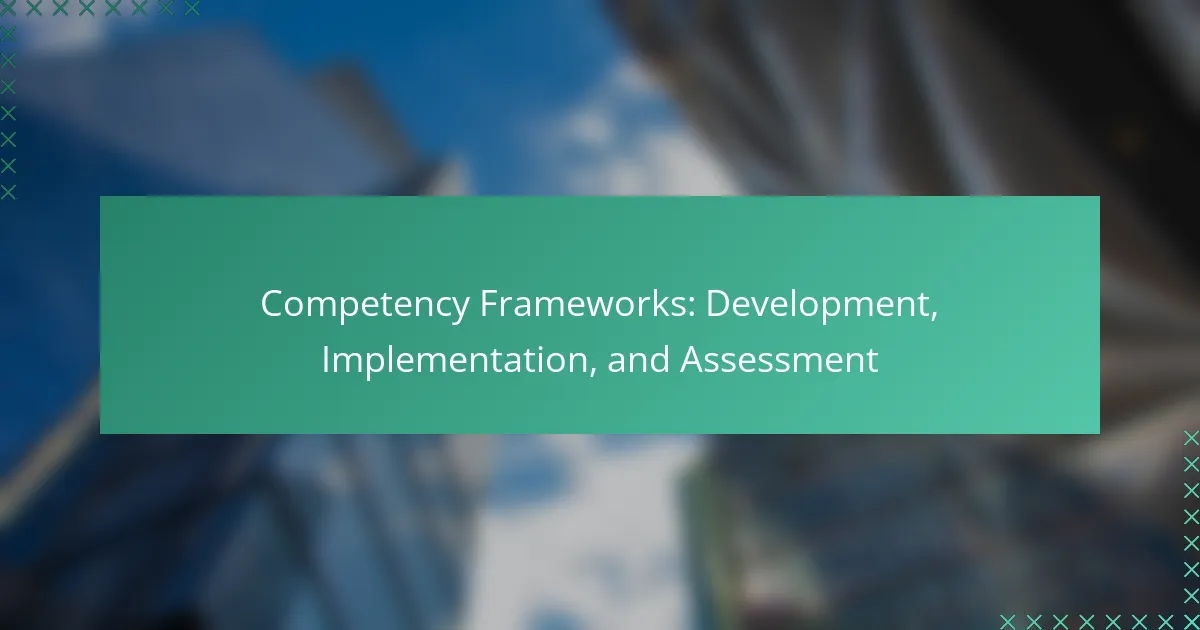Competency frameworks are structured systems that define the skills, knowledge, and behaviors necessary for effective performance in specific roles within an organization. This article outlines the development, implementation, and assessment of competency frameworks, highlighting their role in guiding employee development and performance evaluation. Key steps in the development process include identifying required competencies, validating the framework, and ensuring effective communication and training. The article also discusses methods for assessing competency frameworks, such as surveys and 360-degree feedback, and emphasizes the importance of continuous evaluation to align workforce skills with organizational goals.
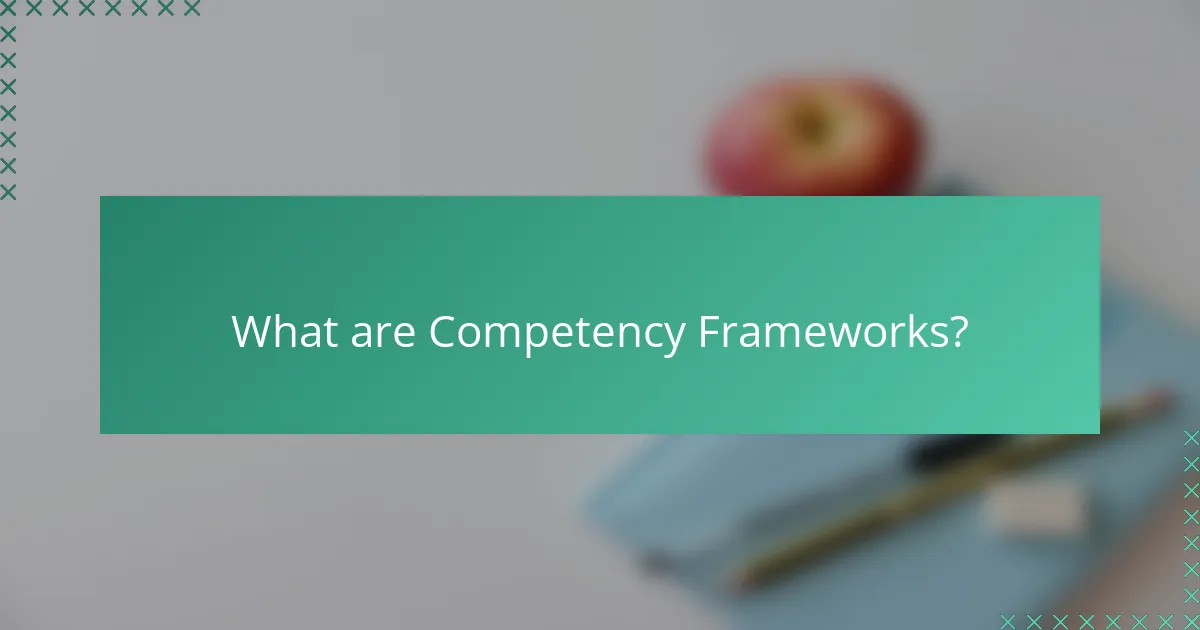
What are Competency Frameworks?
Competency frameworks are structured systems that define the skills, knowledge, and behaviors required for effective performance in specific roles. They serve as a guide for employee development and performance assessment. Competency frameworks often include various competencies categorized under technical and behavioral skills. They help organizations identify training needs and align employee capabilities with business goals. Research indicates that organizations using competency frameworks experience improved performance and employee satisfaction. These frameworks facilitate clear communication of expectations between employers and employees.
How do Competency Frameworks function in organizations?
Competency frameworks function in organizations by defining the skills and behaviors required for various roles. They provide a structured approach to talent management. Organizations use these frameworks to align employee performance with strategic goals. Competency frameworks help in recruitment by outlining necessary qualifications. They guide training and development initiatives by identifying skill gaps. Performance evaluations are informed by these frameworks, ensuring consistency in assessments. Organizations can track employee progress and career development through competency frameworks. According to a study by the Society for Human Resource Management, 70% of organizations report improved performance management with competency frameworks.
What are the key components of a Competency Framework?
The key components of a Competency Framework include competencies, levels of proficiency, and behavioral indicators. Competencies define the skills, knowledge, and abilities required for effective performance. Levels of proficiency outline the degree of expertise expected for each competency. Behavioral indicators provide specific examples of how competencies can be demonstrated in practice. These components work together to create a structured approach to assessing and developing employee skills. Competency frameworks are used in various organizations to align workforce capabilities with strategic goals.
How do these components contribute to employee development?
Components of competency frameworks contribute to employee development by providing clear expectations, structured learning paths, and measurable outcomes. Clear expectations help employees understand required skills and behaviors for their roles. Structured learning paths guide employees through training and development opportunities. Measurable outcomes allow for tracking progress and identifying areas for improvement. Research shows that organizations with competency frameworks experience higher employee engagement and performance. A study by the Society for Human Resource Management found that 63% of organizations using competency frameworks reported improved employee performance.
Why are Competency Frameworks important for workforce management?
Competency frameworks are essential for workforce management because they provide a structured approach to defining required skills and behaviors. They help organizations identify the competencies necessary for various roles. This clarity supports recruitment, training, and performance evaluation. According to a study by the Society for Human Resource Management, organizations using competency frameworks experience improved employee performance and engagement. Competency frameworks also facilitate career development by outlining clear pathways for advancement. They ensure alignment between employee capabilities and organizational goals. This alignment is crucial for driving overall business success.
What advantages do organizations gain from implementing Competency Frameworks?
Organizations gain several advantages from implementing Competency Frameworks. These frameworks provide clear expectations for employee performance. They enhance recruitment by identifying necessary skills and competencies. Competency Frameworks also support employee development through targeted training programs. They facilitate performance management by establishing objective evaluation criteria. Additionally, these frameworks improve organizational alignment by connecting individual roles to business goals. Research indicates that organizations using competency models see increased employee engagement and productivity. For example, a study by the Society for Human Resource Management found that companies with defined competencies have a 20% higher employee retention rate.
How do Competency Frameworks impact employee performance and satisfaction?
Competency frameworks significantly enhance employee performance and satisfaction. These frameworks provide clear expectations for skills and behaviors required in specific roles. When employees understand what is expected, they can align their efforts accordingly. This clarity reduces confusion and increases focus on tasks.
Competency frameworks also support targeted training and development. Employees receive training that directly relates to their roles, improving their skills. Enhanced skills lead to better job performance. Additionally, employees feel more competent and confident in their abilities.
Research shows that organizations using competency frameworks report higher employee engagement. A study by the Society for Human Resource Management found that effective competency frameworks correlate with increased job satisfaction. Employees are more likely to stay with organizations that invest in their development.
In summary, competency frameworks improve performance by clarifying expectations and enhancing skills. They also boost satisfaction by fostering employee development and engagement.
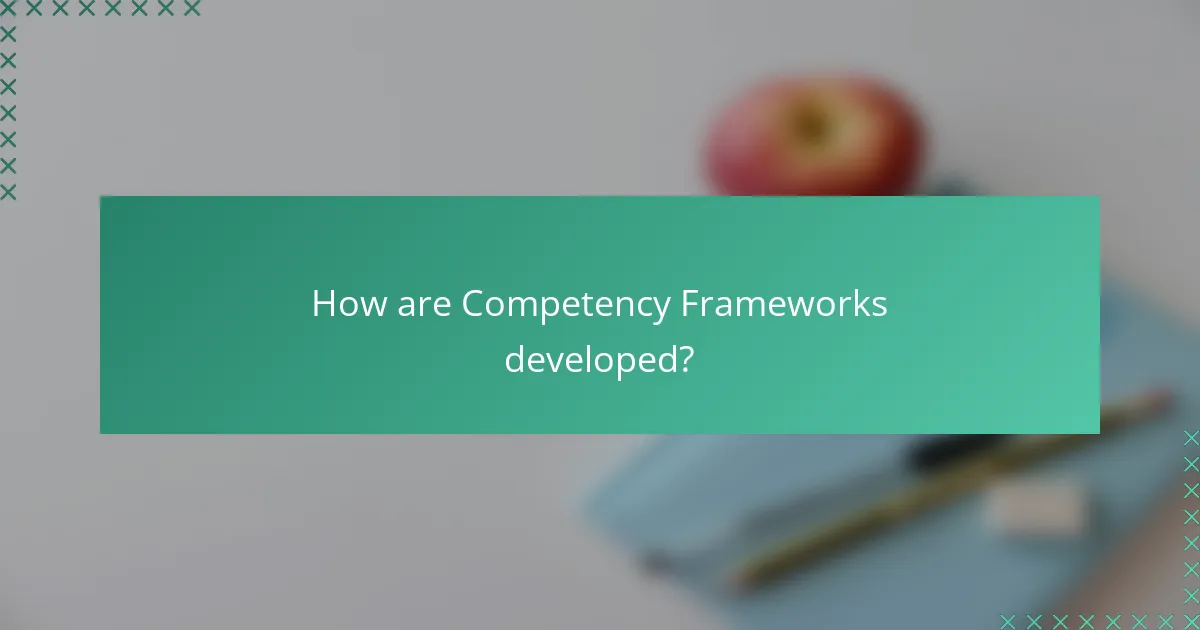
How are Competency Frameworks developed?
Competency frameworks are developed through a structured process involving several key steps. First, organizations identify the specific competencies required for various roles. This identification often involves consulting with stakeholders, including managers and employees. Next, organizations define these competencies clearly, outlining the skills, knowledge, and behaviors needed.
Following this, a validation process occurs. This may include pilot testing the framework with a small group to ensure its relevance and effectiveness. Feedback from this testing phase is crucial for refining the framework.
Once finalized, the framework is documented and communicated to all relevant parties. Training sessions may be conducted to ensure understanding and proper implementation. Continuous evaluation is essential to keep the framework updated with changing organizational needs.
Research indicates that effective competency frameworks enhance performance and align workforce skills with organizational goals.
What are the steps involved in creating a Competency Framework?
Identify organizational goals and objectives. Conduct a job analysis to determine required competencies. Engage stakeholders to gather input and insights. Define core competencies relevant to the organization. Develop behavioral indicators for each competency. Validate the framework through feedback and revisions. Implement the competency framework across relevant HR processes. Evaluate and update the framework regularly to ensure relevance.
How do organizations identify necessary competencies?
Organizations identify necessary competencies through a systematic process. This process often begins with a thorough analysis of job roles and organizational goals. Stakeholder interviews and surveys are commonly used to gather insights. Job descriptions and performance data also provide valuable information. Competency modeling helps in defining the skills required for each role. Additionally, organizations may reference industry standards and best practices. Regular reviews and updates ensure competencies remain relevant. This approach aligns competencies with the organization’s strategic objectives.
What role do stakeholders play in the development process?
Stakeholders play a crucial role in the development process by providing input and feedback. They help define project goals and requirements. Their involvement ensures that the development aligns with user needs and expectations. Stakeholders include clients, team members, and end-users. Their perspectives contribute to informed decision-making. Engaging stakeholders can enhance project success rates. Studies show that projects with active stakeholder participation have higher satisfaction levels. This highlights the importance of their role in the overall development process.
What methodologies are used in developing Competency Frameworks?
Competency frameworks are developed using various methodologies including job analysis, stakeholder interviews, and competency modeling. Job analysis identifies the skills and knowledge required for specific roles. Stakeholder interviews gather insights from employees and management to understand necessary competencies. Competency modeling organizes these competencies into a structured format. Research indicates that combining these methodologies enhances the framework’s relevance and applicability. For example, a study by the Society for Human Resource Management highlights the effectiveness of stakeholder engagement in creating robust competency frameworks.
How does a job analysis contribute to framework development?
A job analysis contributes to framework development by identifying the specific skills, knowledge, and abilities required for various roles. This process helps in defining competencies that are essential for job performance. By gathering data on job tasks and responsibilities, organizations can create a clear structure for competency frameworks. Job analysis ensures that the framework aligns with organizational goals and job expectations. Research indicates that effective job analyses lead to more relevant and targeted competency models. For example, a study by Brannick and Levine (2002) emphasizes the importance of job analysis in developing valid performance assessments. This highlights that job analysis is foundational in ensuring the competency framework is both practical and applicable.
What are the best practices for aligning competencies with organizational goals?
Aligning competencies with organizational goals involves several best practices. First, clearly define organizational goals. This provides a roadmap for competency alignment. Next, conduct a competency assessment. Analyze existing skills and identify gaps relative to the goals. Third, develop targeted training programs. These programs should address specific competency gaps.
Additionally, engage stakeholders in the process. This ensures alignment with diverse perspectives. Regularly review and update competencies. This keeps them relevant as organizational goals evolve. Finally, measure the impact of aligned competencies. Use performance metrics to gauge effectiveness.
Research indicates that organizations with aligned competencies see improved performance. A study by the Society for Human Resource Management found that 94% of employees would stay longer if companies invested in their career development.
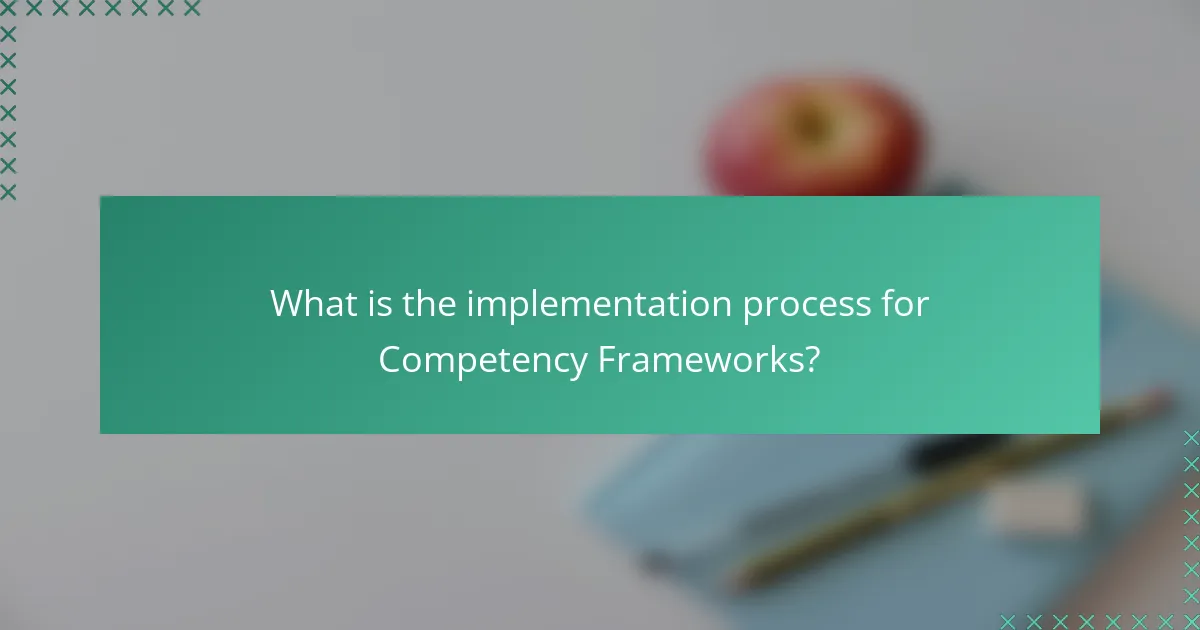
What is the implementation process for Competency Frameworks?
The implementation process for competency frameworks involves several key steps. First, organizations must define the competencies needed for specific roles. Next, they should develop a framework that outlines these competencies and their associated behaviors. Following this, organizations need to communicate the framework to all stakeholders. Training sessions may be conducted to ensure understanding and buy-in. After that, organizations should integrate the framework into existing HR processes, such as recruitment and performance evaluation. Finally, continuous assessment and feedback mechanisms should be established to refine the framework. This structured approach ensures that the competency framework effectively supports organizational goals.
How can organizations effectively implement Competency Frameworks?
Organizations can effectively implement Competency Frameworks by following a structured approach. First, they must define the core competencies relevant to their goals. This involves identifying the skills, knowledge, and behaviors needed for success.
Next, organizations should engage stakeholders in the development process. This ensures that the framework aligns with organizational culture and employee needs.
Training programs should be established to educate employees about the framework. This fosters understanding and encourages buy-in from all levels of the organization.
Regular assessments and feedback mechanisms are crucial. They help in evaluating the effectiveness of the framework and making necessary adjustments.
Lastly, organizations should continuously review and update the framework. This ensures it remains relevant and aligned with changing business objectives and industry standards.
What training and resources are necessary for successful implementation?
Successful implementation requires comprehensive training and adequate resources. Training should include workshops on competency framework principles. Participants need to understand the framework’s structure and objectives. Resources must encompass access to relevant literature and tools. Online platforms can offer courses on implementation strategies. Support from experienced mentors can enhance learning. Continuous evaluation tools are vital for assessing progress. These elements collectively ensure effective integration of competency frameworks.
How do organizations communicate the framework to employees?
Organizations communicate the framework to employees through structured methods. These methods include training sessions, workshops, and informational meetings. Digital platforms also play a crucial role in disseminating the framework. Internal communication tools, such as emails and intranet, are frequently used. Visual aids like charts and infographics help in understanding complex concepts. Feedback mechanisms ensure clarity and address any questions. Regular updates keep employees informed about changes or enhancements to the framework. Research shows that clear communication enhances employee engagement and understanding of organizational goals.
What challenges might arise during the implementation of Competency Frameworks?
Challenges during the implementation of Competency Frameworks include resistance to change among employees. Employees may feel threatened by new expectations. This can lead to a lack of engagement in the process. Additionally, insufficient training can hinder proper understanding of the framework. Organizations may also struggle with aligning the framework to existing roles and responsibilities. This misalignment can create confusion and inconsistencies in performance evaluations. Limited resources and support can further complicate implementation efforts. Without adequate buy-in from leadership, the framework may not be prioritized. These challenges can ultimately affect the overall effectiveness of the competency framework.
How can organizations address resistance to change?
Organizations can address resistance to change by fostering open communication. Clear communication helps employees understand the reasons for change. It also allows them to voice concerns. Involving employees in the change process increases their buy-in. Training and support can ease the transition. Providing resources helps employees adapt to new systems. Leadership must demonstrate commitment to the change. This sets a positive example for the organization. Research shows that organizations with strong change management practices achieve higher success rates. For instance, a study by Prosci indicates that effective communication can enhance project success by 70%.
What strategies can be employed to ensure stakeholder buy-in?
Engaging stakeholders early in the process is crucial for ensuring buy-in. This can be achieved through regular communication and updates. Clearly outlining the benefits of the competency framework helps stakeholders understand its value. Involving stakeholders in the development phase fosters a sense of ownership. Providing training and resources supports their understanding and implementation. Gathering feedback throughout the process allows for adjustments based on stakeholder input. Celebrating early successes demonstrates the framework’s effectiveness. Finally, establishing a clear vision aligns stakeholders with the project’s goals.
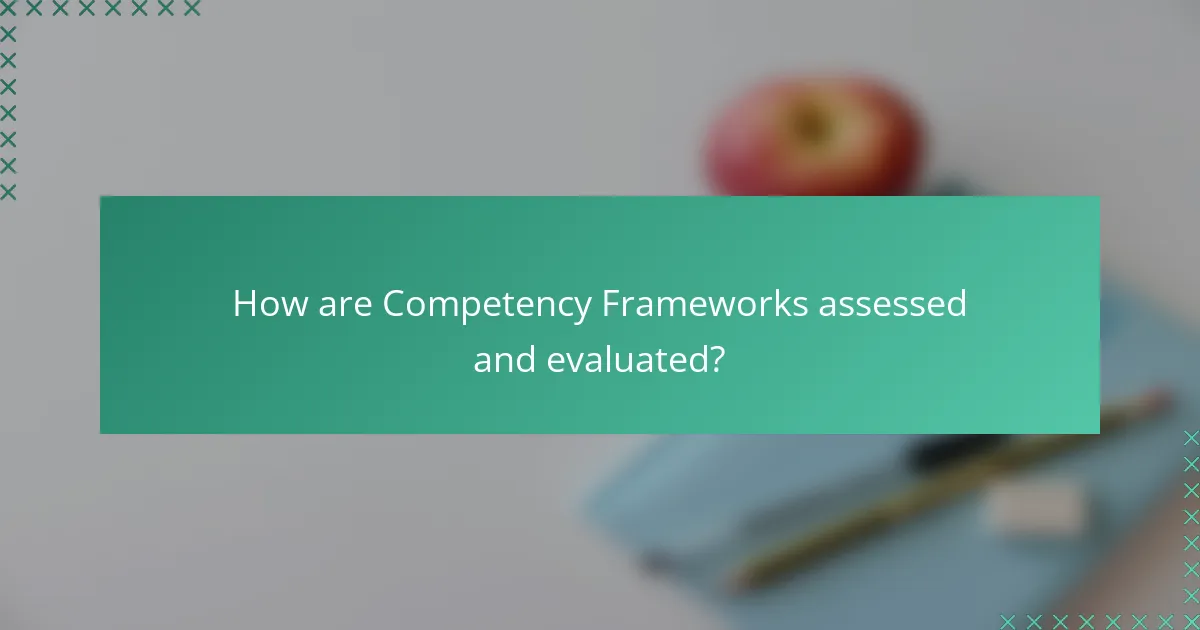
How are Competency Frameworks assessed and evaluated?
Competency frameworks are assessed and evaluated through various methods. These methods include surveys, interviews, and performance reviews. Organizations often utilize 360-degree feedback to gather comprehensive insights. This feedback involves input from peers, supervisors, and subordinates. Additionally, benchmarking against industry standards is common. This helps ensure relevance and effectiveness in specific sectors. Regular updates and revisions are necessary to maintain alignment with organizational goals. Metrics for success may include employee performance and engagement levels. Data collected during evaluations informs future training and development initiatives.
What methods are used to evaluate the effectiveness of Competency Frameworks?
Methods used to evaluate the effectiveness of Competency Frameworks include surveys, performance assessments, and feedback mechanisms. Surveys gather quantitative data on employee perceptions and understanding of the framework. Performance assessments measure how well employees apply competencies in their roles. Feedback mechanisms involve collecting qualitative insights from stakeholders, including managers and peers. These methods help identify gaps and areas for improvement. Research indicates that organizations using these evaluation methods see enhanced employee performance and alignment with organizational goals. For instance, a study by the Society for Human Resource Management found that effective competency frameworks lead to a 25% increase in employee productivity.
How can organizations measure competency development over time?
Organizations can measure competency development over time through various assessment methods. These methods include performance evaluations, skills assessments, and competency frameworks. Performance evaluations provide insights into employee capabilities and growth. Skills assessments can be conducted through tests or practical demonstrations. Competency frameworks outline specific skills and behaviors required for roles. Regular feedback sessions help track progress and identify areas for improvement. Data from these assessments can be analyzed to determine trends in competency development. Research shows that organizations utilizing structured assessments see a 20% increase in employee performance over time.
What feedback mechanisms are essential for continuous improvement?
Essential feedback mechanisms for continuous improvement include regular performance reviews, peer evaluations, and customer feedback. Performance reviews provide structured insights into individual and team effectiveness. Peer evaluations encourage collaboration and accountability among team members. Customer feedback offers direct insights into user satisfaction and areas for enhancement. Implementing these mechanisms fosters a culture of openness and adaptability. Organizations that utilize these feedback methods often experience higher engagement and productivity. Research shows that companies with regular feedback loops see a 14.9% increase in employee performance (Gallup, 2020).
What are common pitfalls in assessing Competency Frameworks?
Common pitfalls in assessing competency frameworks include lack of clarity in definitions. Vague definitions can lead to inconsistent evaluations. Another pitfall is neglecting stakeholder input. Ignoring perspectives from various stakeholders can result in a misaligned framework. Inadequate training for assessors is also a significant issue. Assessors without proper training may misinterpret competencies. Failing to update the framework regularly can lead to obsolescence. Competency requirements can change, and outdated frameworks may not reflect current needs. Lastly, focusing solely on quantitative metrics can overlook qualitative aspects. A balanced assessment should consider both types of data for a comprehensive evaluation.
How can organizations avoid bias in competency assessments?
Organizations can avoid bias in competency assessments by implementing structured assessment tools. These tools standardize evaluation criteria and ensure consistency across all candidates. Training assessors on unconscious bias is crucial. It raises awareness and promotes fair judgment. Utilizing diverse panels for evaluations can also minimize bias. Diverse perspectives contribute to a more balanced assessment. Regularly reviewing assessment outcomes helps identify potential bias patterns. Data analysis can reveal discrepancies in evaluation results among different demographic groups. Organizations should also solicit feedback from candidates about their assessment experience. This feedback can highlight areas needing improvement. By adopting these practices, organizations enhance fairness in their competency assessments.
What role does data analysis play in evaluating competency effectiveness?
Data analysis plays a crucial role in evaluating competency effectiveness. It enables organizations to assess the skills and knowledge of employees quantitatively. By analyzing performance metrics, organizations can identify gaps in competencies. This data-driven approach allows for targeted training and development initiatives. For instance, a study by the Association for Talent Development found that companies utilizing data analysis saw a 20% increase in employee performance. Furthermore, data analysis helps in tracking progress over time, ensuring that competency frameworks remain relevant. It also supports decision-making by providing insights into which competencies drive organizational success.
What are best practices for maintaining and updating Competency Frameworks?
Best practices for maintaining and updating competency frameworks include regular reviews and stakeholder engagement. Organizations should schedule annual evaluations to ensure relevance. Feedback from employees and managers is crucial for identifying gaps. Aligning frameworks with organizational goals enhances their effectiveness. Incorporating industry trends keeps competencies current. Training and development programs should reflect updates in the framework. Documentation of changes aids in transparency and accountability. Regular communication about updates fosters understanding and acceptance among staff.
Competency frameworks are structured systems that define the skills, knowledge, and behaviors necessary for effective performance in specific roles within organizations. This article covers the development, implementation, and assessment of competency frameworks, detailing their key components, functions, and the advantages they offer for workforce management. It explores best practices for aligning competencies with organizational goals, the methodologies used in framework development, and the importance of stakeholder engagement. Additionally, the article addresses common challenges in implementation, methods for evaluating effectiveness, and strategies for continuous improvement.
